
The American Pygmy is an American breed of achondroplastic (dwarf) goat. It is small, compact and stockily built. Like the Nigerian Dwarf, it derives from the West African Dwarf group of breeds of West Africa. Between 1930 and 1960, animals of this type were imported to the United States for use either as zoo animals or for research; some were later kept and bred as companion animals and established as a breed in 1975.

The Corriente is an American breed of small cattle, used principally for rodeo events. It derives from Criollo Mexicano stock, which in turn descends from Iberian cattle brought to the Americas by the Conquistadores, and introduced in the sixteenth and seventeenth centuries to various parts of what is now Mexico.

The Belted Galloway is a traditional Scottish breed of beef cattle. It derives from the Galloway cattle of the Galloway region of south-western Scotland, and was established as a separate breed in 1921. It is adapted to living on the poor upland pastures and windswept moorlands of the region. The exact origin of the breed is unclear, although the white belt for which they are named, and which distinguishes the breed from black Galloway cattle, is often surmised to be the result of cross-breeding with the similarly-coloured Dutch Lakenvelder breed.

The Jacob is a British breed of domestic sheep. It combines two characteristics unusual in sheep: it is piebald—dark-coloured with areas of white wool—and it is often polycerate or multi-horned. It most commonly has four horns. The origin of the breed is not known; broken-coloured polycerate sheep were present in England by the middle of the seventeenth century, and were widespread a century later. A breed society was formed in 1969, and a flock book was published from 1972.

The Randall Lineback or Randall is an American breed of cattle. It originated in Bennington County, Vermont, and is critically endangered.
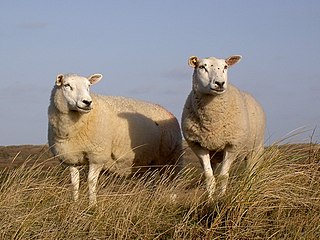
The Texel is a Dutch breed of domestic sheep originally from the island of Texel. It is a heavy and muscular sheep, and produces a lean meat carcass. It is polled, clean-faced and clean-legged, with white face and wool. The fibre diameter of the wool averages about 32 μ, with a staple length of 8–15 cm; it is used mainly for knitting and hosiery wools.

The Dorset Horn is an endangered British breed of domestic sheep. It is documented from the seventeenth century, and is highly prolific, sometimes producing two lambing seasons per year. Among British sheep, it is the only breed capable of breeding throughout the winter.
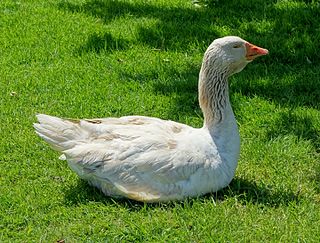
The American Buff is an American breed of domestic goose. It was accepted by the American Poultry Association in 1947. It is named for its single plumage variety, which is a pale buff or apricot-fawn in color.

The Bourbon Red is an American breed of domestic turkey. It is named for its reddish-brown plumage and for its area of origin, Bourbon County, Kentucky, where it was developed in the last years of the nineteenth century. It was accepted into the Standard of Perfection of the American Poultry Association in 1909, and in the early twentieth century was an important commercial meat breed until the Broad Breasted White began to dominate industrial production. The Bourbon Red is considered a heritage turkey; it is an endangered breed, classified as 'watch' by the Livestock Conservancy. It was formerly known as the Bourbon Butternut or as the Kentucky Red.

The Livestock Conservancy, formerly known as the American Livestock Breeds Conservancy (ALBC) and prior to that, the American Minor Breeds Conservancy, is a nonprofit organization focused on preserving and promoting rare breeds, also known as "heritage breeds" of livestock. Founded in 1977, through the efforts of livestock breed enthusiasts concerned about the disappearance of many of the US's heritage livestock breeds, The Livestock Conservancy was the pioneer livestock preservation organization in the United States, and remains a leading organization in that field. It has initiated programs that have saved multiple breeds from extinction, and works closely with similar organizations in other countries, including Rare Breeds Canada. With 3,000 members, a staff of eleven and a 19-member board of directors, the organization has an operating budget of over a million dollars.

The American Rabbit is a breed of rabbit, recognized by the American Rabbit Breeders Association (ARBA) in 1917. By the ARBA standard, American rabbits have a mandolin body shape. It has also been noted for a good 'sweet' temperament and good mothering abilities. As with all domestic rabbits, the American breed is of the species Oryctolagus cuniculus, the European wild rabbit.

The Red Wattle Hog is a breed of domestic pig originating in the United States. It is named for its red color and distinctive wattles or tassels, and is on the threatened list of the American Livestock Breeds Conservancy (ALBC).

The Buckeye is an American breed of chicken. It was created in Ohio in the late nineteenth century by Nettie Metcalf. The color of its plumage was intended to resemble the color of the seeds of Aesculus glabra, the Ohio Buckeye plant for which the state is called the 'Buckeye State'.
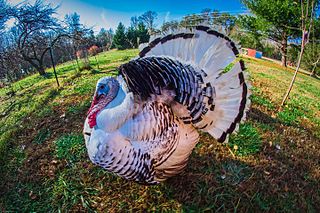
The Royal Palm is a breed of domestic turkey. It is not primarily selected for meat production, and is usually kept as an ornamental bird with a unique appearance, largely white with bands of metallic black.
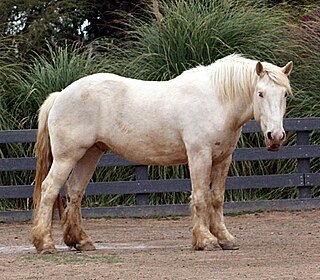
In modern agriculture, a rare breed is a breed of poultry or livestock that has a very small breeding population, usually from a few hundred to a few thousand. Because of their small numbers, rare breeds may have a threatened conservation status, and they may be protected under regional laws. Many countries have organizations devoted to the protection and promotion of rare breeds, for which they each have their own definition. In botany and horticulture, the parallel to rare animal breeds are heirloom plants, which are rare cultivars.
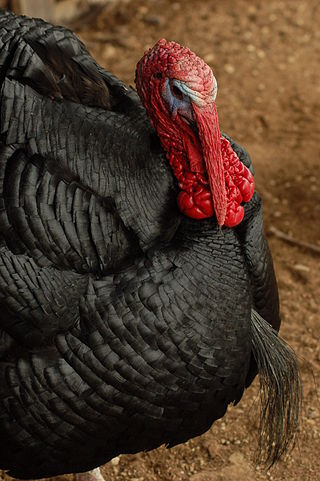
The Norfolk Black, also known as the Black Spanish or Black Turkey, is a British breed of domestic turkey. It is thought to derive from birds taken to Britain from Spain, where they had arrived with Spanish explorers returning from the New World.

The American Milking Devon is an American breed of dual-purpose cattle, reared both for milk and for beef. It derives from the Devon cattle of the United States, which in turn are derived from the North Devon cattle of south-west England. It was established as a separate breed in 1978 with the formation of the American Milking Devon Cattle Association, after the breeding aims of the Devon were concentrated almost exclusively on beef production. It is a rare breed: its conservation status is listed as by the Livestock Conservancy as 'critical'.
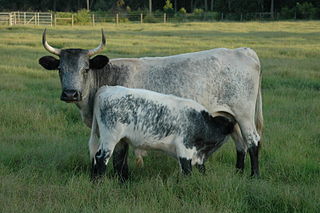
The Florida Cracker or Florida Scrub is an American breed of cattle which originated in Spanish Florida and later in the American state of Florida. It is named for the Florida cracker culture in which it was kept. It is one of the Criollo breeds that descend from the Spanish cattle originally brought to the Americas by the Spanish Conquistadors; among the other North American breeds in this group are the Pineywoods, the Corriente and Texas Longhorn. Unlike the Pineywoods – to which it is closely related – the Florida Cracker has not been inter-bred with breeds of North European origin.

The Guinea Hog is an American breed of small black pig. Since 2006 it has officially been named the American Guinea Hog. Its origins are unknown; a connection to the Essex pigs of eastern England has been suggested. It is apparently unconnected to an older pig also known as Guinea Hog or Red Guinea, which disappeared in the late nineteenth century.
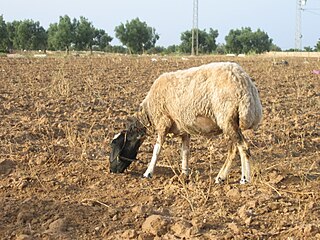
The Tunisian Barbarin is a Tunisian breed of fat-tailed sheep. It is distributed throughout Tunisia, and on both sides of the Tunisian border with Algeria, on the Algerian side particularly in the area of Oued Souf. Related to the Awassi




















